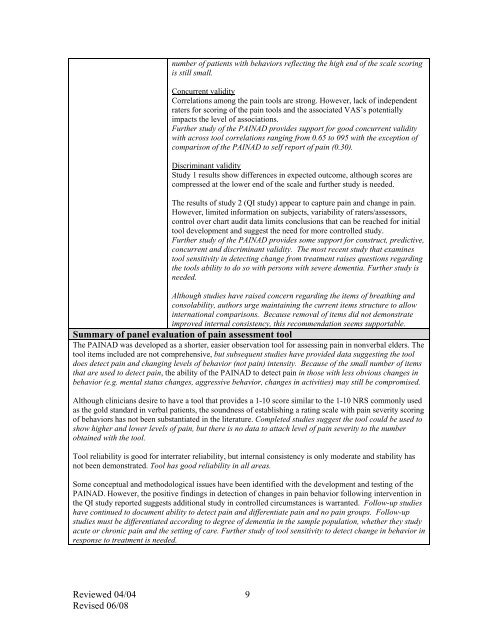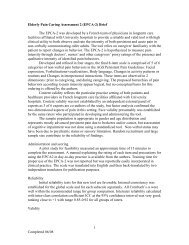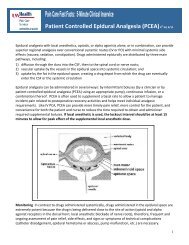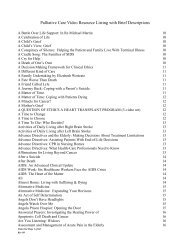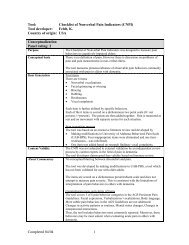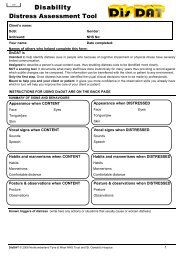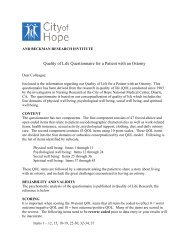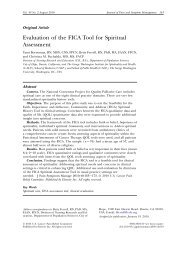Pain Assessment in Advanced Dementia - Pain Resource Center
Pain Assessment in Advanced Dementia - Pain Resource Center
Pain Assessment in Advanced Dementia - Pain Resource Center
Create successful ePaper yourself
Turn your PDF publications into a flip-book with our unique Google optimized e-Paper software.
number of patients with behaviors reflect<strong>in</strong>g the high end of the scale scor<strong>in</strong>gis still small.Concurrent validityCorrelations among the pa<strong>in</strong> tools are strong. However, lack of <strong>in</strong>dependentraters for scor<strong>in</strong>g of the pa<strong>in</strong> tools and the associated VAS’s potentiallyimpacts the level of associations.Further study of the PAINAD provides support for good concurrent validitywith across tool correlations rang<strong>in</strong>g from 0.65 to 095 with the exception ofcomparison of the PAINAD to self report of pa<strong>in</strong> (0.30).Discrim<strong>in</strong>ant validityStudy 1 results show differences <strong>in</strong> expected outcome, although scores arecompressed at the lower end of the scale and further study is needed.The results of study 2 (QI study) appear to capture pa<strong>in</strong> and change <strong>in</strong> pa<strong>in</strong>.However, limited <strong>in</strong>formation on subjects, variability of raters/assessors,control over chart audit data limits conclusions that can be reached for <strong>in</strong>itialtool development and suggest the need for more controlled study.Further study of the PAINAD provides some support for construct, predictive,concurrent and discrim<strong>in</strong>ant validity. The most recent study that exam<strong>in</strong>estool sensitivity <strong>in</strong> detect<strong>in</strong>g change from treatment raises questions regard<strong>in</strong>gthe tools ability to do so with persons with severe dementia. Further study isneeded.Although studies have raised concern regard<strong>in</strong>g the items of breath<strong>in</strong>g andconsolability, authors urge ma<strong>in</strong>ta<strong>in</strong><strong>in</strong>g the current items structure to allow<strong>in</strong>ternational comparisons. Because removal of items did not demonstrateimproved <strong>in</strong>ternal consistency, this recommendation seems supportable.Summary of panel evaluation of pa<strong>in</strong> assessment toolThe PAINAD was developed as a shorter, easier observation tool for assess<strong>in</strong>g pa<strong>in</strong> <strong>in</strong> nonverbal elders. Thetool items <strong>in</strong>cluded are not comprehensive, but subsequent studies have provided data suggest<strong>in</strong>g the tooldoes detect pa<strong>in</strong> and chang<strong>in</strong>g levels of behavior (not pa<strong>in</strong>) <strong>in</strong>tensity. Because of the small number of itemsthat are used to detect pa<strong>in</strong>, the ability of the PAINAD to detect pa<strong>in</strong> <strong>in</strong> those with less obvious changes <strong>in</strong>behavior (e.g. mental status changes, aggressive behavior, changes <strong>in</strong> activities) may still be compromised.Although cl<strong>in</strong>icians desire to have a tool that provides a 1-10 score similar to the 1-10 NRS commonly usedas the gold standard <strong>in</strong> verbal patients, the soundness of establish<strong>in</strong>g a rat<strong>in</strong>g scale with pa<strong>in</strong> severity scor<strong>in</strong>gof behaviors has not been substantiated <strong>in</strong> the literature. Completed studies suggest the tool could be used toshow higher and lower levels of pa<strong>in</strong>, but there is no data to attach level of pa<strong>in</strong> severity to the numberobta<strong>in</strong>ed with the tool.Tool reliability is good for <strong>in</strong>terrater reliability, but <strong>in</strong>ternal consistency is only moderate and stability hasnot been demonstrated. Tool has good reliability <strong>in</strong> all areas.Some conceptual and methodological issues have been identified with the development and test<strong>in</strong>g of thePAINAD. However, the positive f<strong>in</strong>d<strong>in</strong>gs <strong>in</strong> detection of changes <strong>in</strong> pa<strong>in</strong> behavior follow<strong>in</strong>g <strong>in</strong>tervention <strong>in</strong>the QI study reported suggests additional study <strong>in</strong> controlled circumstances is warranted. Follow-up studieshave cont<strong>in</strong>ued to document ability to detect pa<strong>in</strong> and differentiate pa<strong>in</strong> and no pa<strong>in</strong> groups. Follow-upstudies must be differentiated accord<strong>in</strong>g to degree of dementia <strong>in</strong> the sample population, whether they studyacute or chronic pa<strong>in</strong> and the sett<strong>in</strong>g of care. Further study of tool sensitivity to detect change <strong>in</strong> behavior <strong>in</strong>response to treatment is needed.Reviewed 04/04Revised 06/089


